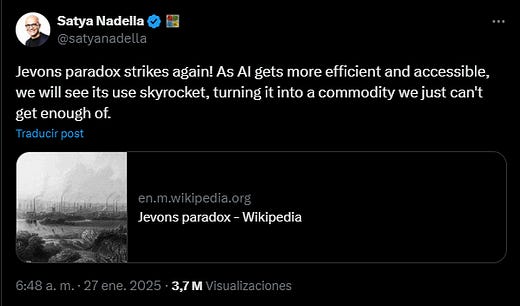Brace for the Great AI Crash: Why Overcapacity and Jevons Paradox Always Burst the Bubble
A Grim Warning: Massive Overbuild and Irrational Growth Set the Stage for the Next Tech Collapse
Hi everyone!
The conversation around AI has reached fever pitch. Headlines tout revolutionary breakthroughs, corporations trumpet multi-billion-dollar investments, and the general public anticipates an era of transformative change. At the same time, a longstanding economic principle—Jevons paradox—suggests that when technology makes a resource more efficient or cheaper to use, overall consumption of that resource ultimately increases. In other words, efficiency gains lead to more widespread adoption, feeding even greater demand. Many would expect AI to follow this pattern: as data processing becomes more efficient, we’d presumably see a corresponding surge in AI’s profitability and usage.
However, for investors keeping an eye on the bottom line, the situation is more nuanced—and arguably more troubling. While major tech companies like Microsoft and others are pouring hundreds of billions of dollars into data centers and AI infrastructure, the returns have yet to match the dizzying scale of capital expenditures. According to Microsoft’s recent earnings call, the company reported a $13 billion run rate from AI initiatives but is poised to invest an additional $40 billion in capital expenditures. It’s a disparity that raises the question: Is AI truly following Jevons paradox, where more efficient compute leads to more profitable adoption, or are we witnessing a bubble with underwhelming returns on invested capital?
In this article, we’ll explore why Jevons paradox might not fully apply to AI from an investor’s vantage point. Instead of a neat, self-reinforcing cycle—where improving efficiencies drive exponentially higher usage and profits—AI appears to be locked in a race for scale that requires enormous spending without reliably delivering commensurate ROIC. By examining the economic fundamentals, competitive pressures, and capital expenditure trends behind this “AI boom,” we can better understand whether it’s poised to generate real returns or simply fuel the next speculative bubble.
Jevons Paradox: Definition and Historical Context
Jevons paradox, named after the 19th-century English economist William Stanley Jevons, describes a counterintuitive phenomenon: when technological advancements improve the efficiency of using a given resource, the overall consumption of that resource often increases rather than decreases. Jevons first observed this paradox in his 1865 work, The Coal Question, which examined Britain’s use of coal during the Industrial Revolution. At the time, steam engines were becoming more efficient, requiring less coal to generate the same amount of power. Conventional wisdom would suggest that coal consumption should decline in response. Instead, Britain’s coal usage skyrocketed, propelled by the broadened range of new applications and economic activities that more efficient engines enabled.
The steam engine example is perhaps the most iconic illustration of Jevons paradox, but the dynamic has recurred in other contexts. For instance, as internal combustion engines improved over the 20th century, cars became more fuel-efficient—yet car ownership soared, total miles traveled increased, and overall gasoline consumption grew. In agriculture, improved irrigation technologies can make water usage more efficient on a per-acre basis; however, farmers often respond by irrigating more acres or planting more water-intensive crops, leading to a net rise in total water usage.
At its core, Jevons paradox highlights a feedback loop between efficiency and demand:
Increased Efficiency: Technological improvements lower the cost or resource intensity of a product or service.
Lower Prices or Costs: Consumers and firms perceive these improvements as opportunities to save money or to use the product more freely.
Higher Aggregate Demand: Because it’s cheaper to operate or consume, usage becomes more widespread.
Increased Overall Consumption: Paradoxically, total resource consumption can end up surpassing the levels seen before the efficiency gains.
In classical markets, this phenomenon can be self-reinforcing: the more a resource becomes available and affordable, the more it spurs new use cases and consumption patterns. Critics of Jevons paradox, however, note that it doesn’t always hold—particularly in highly regulated environments or when markets exhibit other constraints. Yet, when it does apply, it reshapes the narrative around “efficiency as a silver bullet” for reducing consumption, underscoring the need to consider broader economic responses beyond the initial gains from technological progress.
DeepSeek: Transforming AI Economics Through Efficiency
Over the past few years, DeepSeek’s family of AI models (V3, R1, and most recently, R1-Zero) has been at the forefront of a seismic shift in how large-scale models are trained and deployed. While early large language models (like “o1”) demonstrated remarkable capabilities, they were often prohibitively expensive to train and operate, leaving many companies struggling to balance innovation against computational cost. DeepSeek, by contrast, has leveraged a suite of breakthroughs—activated parameters, novel reinforcement learning strategies, and distillation techniques—to cut operating costs by 90–95% relative to o1, all while maintaining or even improving performance. Here’s how these advancements came to be and why they matter.
Continúa leyendo con una prueba gratuita de 7 días
Suscríbete a Gutiérrez Capital para seguir leyendo este post y obtener 7 días de acceso gratis al archivo completo de posts.




